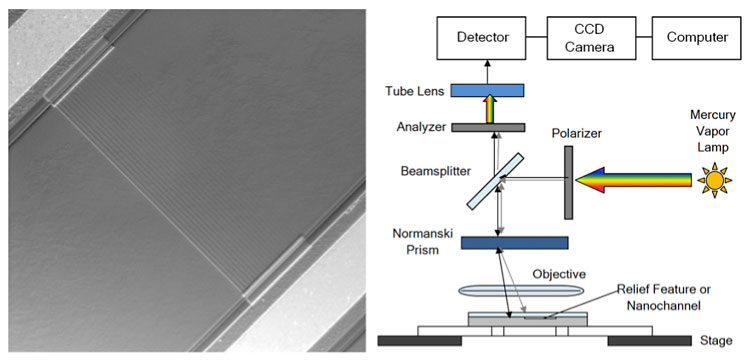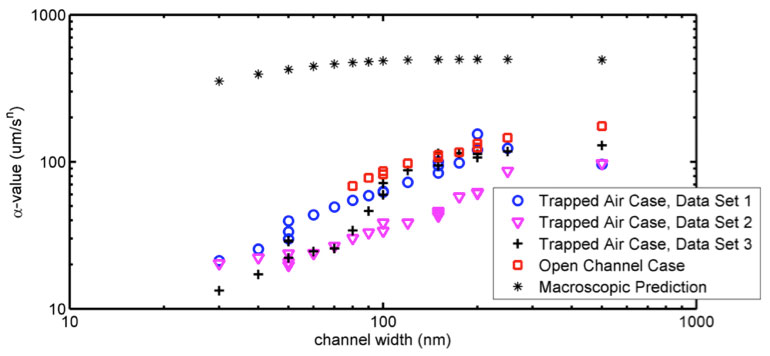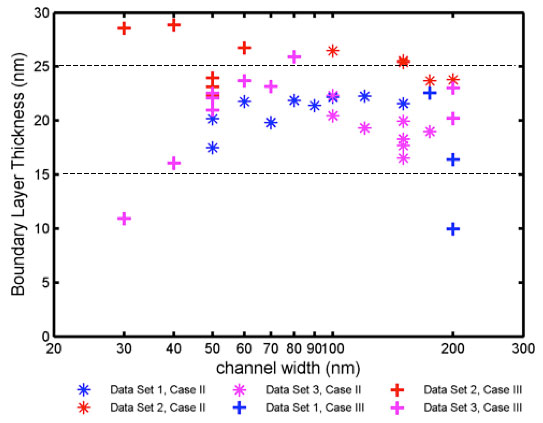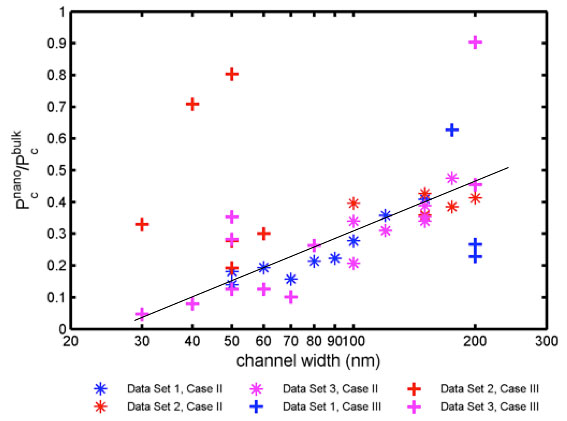Reports: ND952817-ND9: Investigation of Fundamental Dynamic Petrophysical Properties of Gas-Bearing Shales
Matthew T. Balhoff, University of Texas at Austin
(Shaina Kelly, Carlos Torres-Verdin, Matthew Balhoff) Technical Overview
Interest in liquid behavior within nano-confinements spans many disciplines. Geophysical interest originates from a desire to understand fluid flow mechanisms through hydrocarbon-rich nano-porous shale media. This work investigates the extent of boundary layer nucleation during polar liquid flows in hydrophilic nano-confinements via discrepancies seen in viscosity and capillary pressure from their bulk values. As opposed to thin films and nano-slits, we perform our experiments in two-dimensional nanochannels of varying size and as small as 30 x 60 nm in cross section and obtain visual data with reflected differential interference contrast microscopy. The simple geometry of the nanochannels enables comparison against analytical transport solutions. Our current experiments are performed with the organic solvent isopropanol within siliceous nanochannels. We have experimented with aqueous solutions, hydrocarbons, keytones, and alcohols in the nanochannels and found isopropanol, a polar wetting solution, to be ideal for experimentation due to its consistent wetting abilities (i.e. a contact angle of approximately zero, which reduces sensitivity to cases of slight contamination and dehdroxylization).
We report anomalies in the trends of open-ended channel imbibition, where isopropanol imbibes into the nanochannels from one microchannel reservoir and the microchannel at the terminating end is open to the atmosphere. By designing a nanochannel experiment that allows us to monitor the rate of liquid imbibition and volume loss of a trapped air pocket the liquid is imbibing into, we are able to decouple capillary pressure and viscosity from imbibition data, as well as gain information about the gas partitioning coefficient at the meniscus interface. The results of the decoupling scheme indicate that for siliceous, rectangular nanochannels with heights of 60 nm and varying sub-micron widths, effective viscosity is consistently at least 4 times higher than the bulk value and capillary pressure is around 50% less than the macroscopic Young-Laplace equation prediction. Calculated gas partitioning coefficients at the meniscus interface indicate that the area available for gas partitioning is proportionally less in the smaller nanochannels. The results equate to the nucleation of structured boundary layers consistently 15-25 nm in extent, which is far thicker than the extent prescribed by long range intermolecular force interactions. The most plausible argument for boundary layers of this magnitude is the formation of a quasi-crystalline zone of isopropanol molecules at the negatively charged silica surfaces stymied by surface roughness, trace impurities, and significant viscous shearing induced by the swift momentum transfer of imbibition. If the density of the structured zone molecules is great enough it can be imagined to create an annular zone of high viscosity through which the bulk fluid flows. Quasi-crystalline boundary layers have an inherently increased viscosity and molecular ordering compared to the liquid bulk value, resulting in a significant reduction in imbibition efficacy and gas partitioning.
The presence of approximately 15-25 nm quasi-crystalline boundary layers in on the threshold of two different theories – thin boundary layers and thick quasi-crystalline boundary layers – and beckons deeper inspection into what controls the extent of boundary layer termination during fluid flow in hydrophilic two-dimensional nano-confinements. Impact of Research
Geological media, including shale, contains an abundance of charged surfaces (the negative charges at clay and grain surfaces is well known). The surface chemistry of kerogen is still a subject of investigation, though many researchers suggest that kerogen hydrophilicity is dependent on maturity. Understanding the interaction of water, a polar molecule, as well as surfactant polymers, fluids subject to surface-induced crystalline ordering, with these charged surfaces in nano-confinements is of great importance for describing the time scale of hydraulic fracture and shale matrix interactions, designing more effective hydraulic fracture fluids, liquid-based core analysis methods, etc. Overall, this work adds a unique experimental method and dynamic data with a specific solid material and fluid combination in two-dimensional nano-scale confinements to a growing body of literature which suggests that the study and description of liquid flow and imbibition in nano-confinements may involve the subject of surface chemistry just as much as it does hydrodynamic momentum transfer. PI and Student Career Impacts
Partaking in nanofluidics research presents researchers with a number of challenges and is not in the scope of conventional petroleum engineering lab-work. By undertaking such experiments our group has gained knowledge of and access to various nano-fabrication and nano-scale chracterization tools ranging from electron beam lithography to environmental scanning electron microscopy. Familiarity with the capabilities of these resources will undoubtedly lead to further formulation of non-typical and pore-scale petroleum engineering research projects by the PI and students. Figures

Figure 1. (Left) Example of a reflected DIC image of a nanochannel array spanning between two microchannels taken with a Zeiss Axioskop 2 MAT in monochromatic mode. (Right) Schematic of reflected DIC microscopy.

Figure 2. When the wicking coefficients or α-values are extracted from the data via l=αtn, these coefficients are significantly less than the Washburn equation for imbibition's macroscopic prediction and decrease more dramatically with smaller channel size for all experimental cases. For the open-ended channel case it was difficult to visually capture data in the nanochannels smaller than 80 nm in width.

Figure 3. Using the decoupled values for effective viscosity, the extent of structured zones is estimated by assuming these zones are immobile and that the non-structured inner region of each nanochannel has the bulk isopropanol viscosity value. The majority of the back-calculated boundary layer extents fall between 15-25 nm.

Figure 4. The ratio of the decoupled capillary pressure values over the bulk value (Young-Laplace equation) for isopropanol versus nanochannel width reveal that apparent capillary pressure is significantly decreased in the nanochannels by 50% or more for the majority of the data points. A rough trend of increasing capillary pressure with increasing width (the opposite of the macroscopic prediction) is also seen with a few outliers. The decoupled capillary pressure values correspond to effective contact angles of greater than 60°, far greater than the macroscopic contact angle for isopropanol on silica.











